Physical Address
304 North Cardinal St.
Dorchester Center, MA 02124
Physical Address
304 North Cardinal St.
Dorchester Center, MA 02124
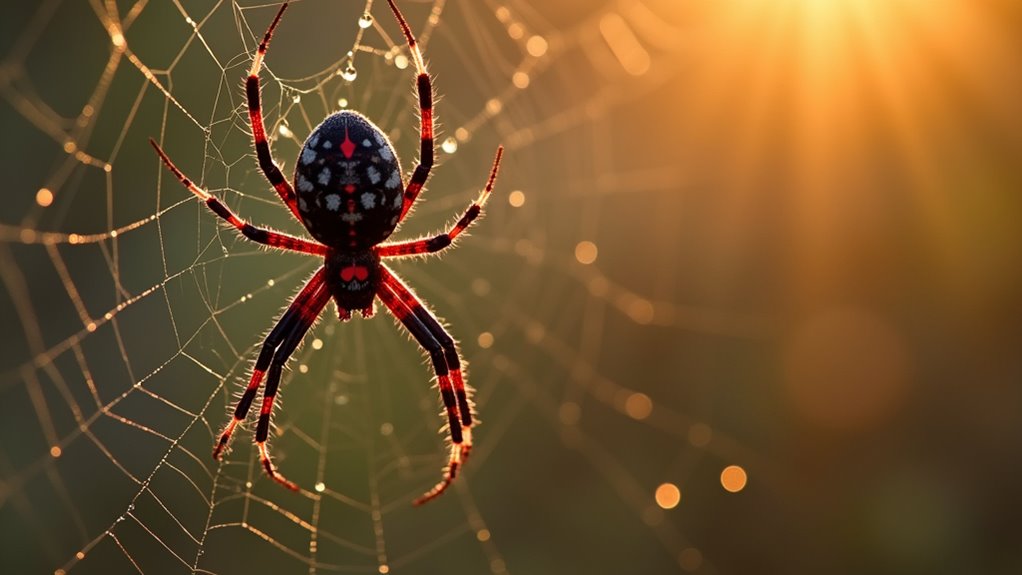
Terrifying or helpful? California's spider kingdom houses 7 distinct species that might surprise you when exploring the Golden State.
Did you know California houses over 40 different spider families, creating one of the most diverse arachnid populations in North America? You’ll encounter everything from massive tarantulas patrolling desert floors to tiny jumping spiders hunting on your garden plants. While most pose no threat to humans, distinguishing between beneficial species and those requiring caution can make your outdoor adventures safer and more enjoyable. Let’s explore the seven most notable eight-legged residents you’re likely to meet in the Golden State.
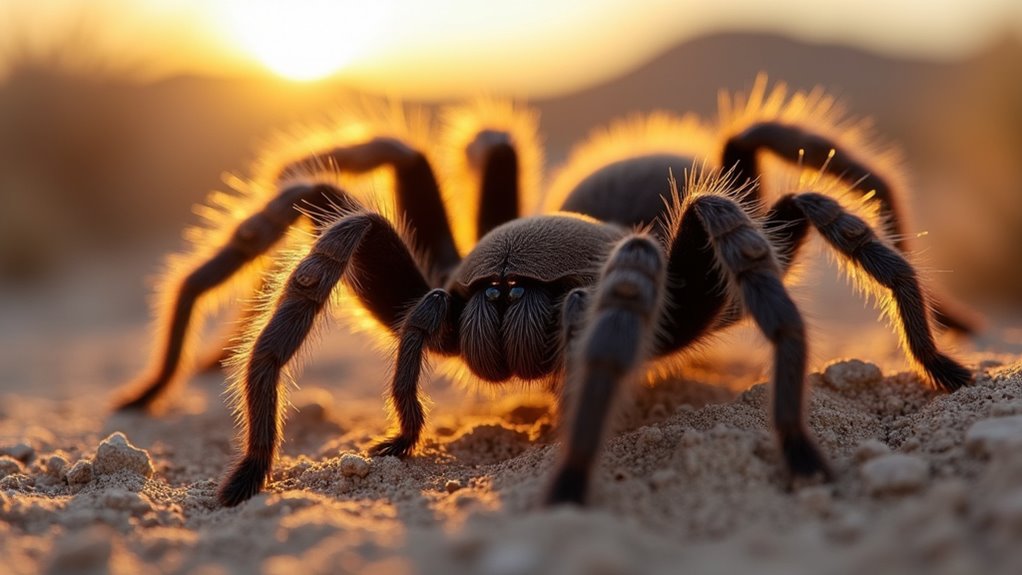
While often misunderstood, California tarantulas are fascinating arachnids that inhabit the state’s diverse landscapes. You’ll find these gentle giants in grasslands and semi-arid regions throughout California, particularly in Bay Area foothills and around Mount Diablo.
California’s tarantulas may seem intimidating, but these misunderstood arachnids are gentle residents of our grasslands and foothills.
The two primary species—California Ebony and San Diego Bronze—typically reach 3-5 inches in leg span. These tarantulas use their urticating hairs as a defense mechanism when threatened, flicking them toward potential predators. Despite their intimidating appearance, they’re non-aggressive and their venom isn’t harmful to humans.
Males live 5-10 years, while females can survive an impressive 25-30 years.
If you’re hiking from September to October, you might spot males during their mating migrations. That’s when they leave their burrows searching for females.
These nocturnal hunters help control insect populations and prefer to avoid human contact unless disturbed. Both Seattle and San Francisco residents can enjoy observing these fascinating creatures, though California’s warmer climate makes it a more natural habitat for tarantulas.
The black widow spider, with its infamous red hourglass marking, is perhaps California’s most recognizable arachnid. Females display this distinctive marking on their shiny black, globular abdomens. You’ll typically find these nocturnal hunters in dry, sheltered areas around your property, building irregular, tangled webs close to ground level. Black widows prefer secretive locations like water meter boxes, cracks, crevices, and animal burrows.
Despite their fearsome reputation, black widows aren’t aggressive and only bite when pressed against skin. If you encounter one, remember:
To prevent infestations, reduce clutter around your home, seal entry points, and wear gloves when gardening. Senior travelers should take extra precautions when visiting California, as they’re among the more vulnerable populations if bitten.
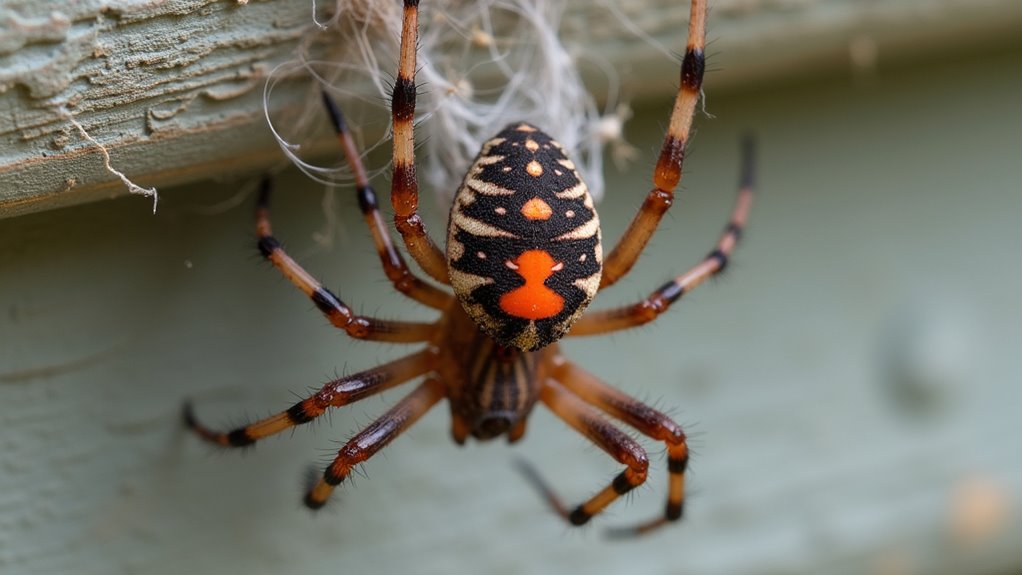
California’s lesser-known brown widow spider has been steadily expanding its territory throughout Southern California. Native to southern Africa, this invasive species now thrives from San Diego to Los Angeles and Riverside counties, often displacing black widows in urban areas.
You’ll recognize brown widows by their mottled tan, brown, and gray coloration with an orange or yellowish hourglass on the abdomen. Their distinctive egg sacs are tan and spherical with spiky protrusions resembling thistles.
While they share similarities with black widows, brown widows are more timid and their bites are typically less severe.
You’ll find them in secluded spots like wood piles, patio furniture, and under vegetation. Unlike the exotic island paradises of Hawaii or Fiji, brown widows prefer urban environments closer to home. These prolific breeders can produce up to 20 egg sacs in their lifetime, each containing 120-150 eggs. To manage populations, remove clutter and regularly sweep away their messy, irregular webs.
Have you ever marveled at the intricate, wheel-shaped webs that appear overnight in your garden? These masterpieces belong to orb weavers, Southern California’s colorful garden architects. These spiders range from 6-20mm with vibrant orange, brown, and black patterns on their rounded abdomens.
Nature’s nocturnal artists, orb weavers spin delicate geometric marvels while you sleep, their colorful bodies bright against morning dew.
You’ll typically spot orb weavers during summer months near outdoor lights or between plants where flying insects abound. Their ecological importance can’t be overstated—they’re natural pest controllers that help maintain insect populations. While Americans might enjoy classic dishes from various regions, these natural architects provide a different kind of cultural experience in our backyards. Many species actually consume and completely rebuild their webs daily, which helps prevent debris accumulation and maintains the web’s effectiveness for catching prey.
Their web-building process follows four distinct phases:
Though they can bite if threatened, orb weavers are harmless to humans and prefer fleeing to confrontation.
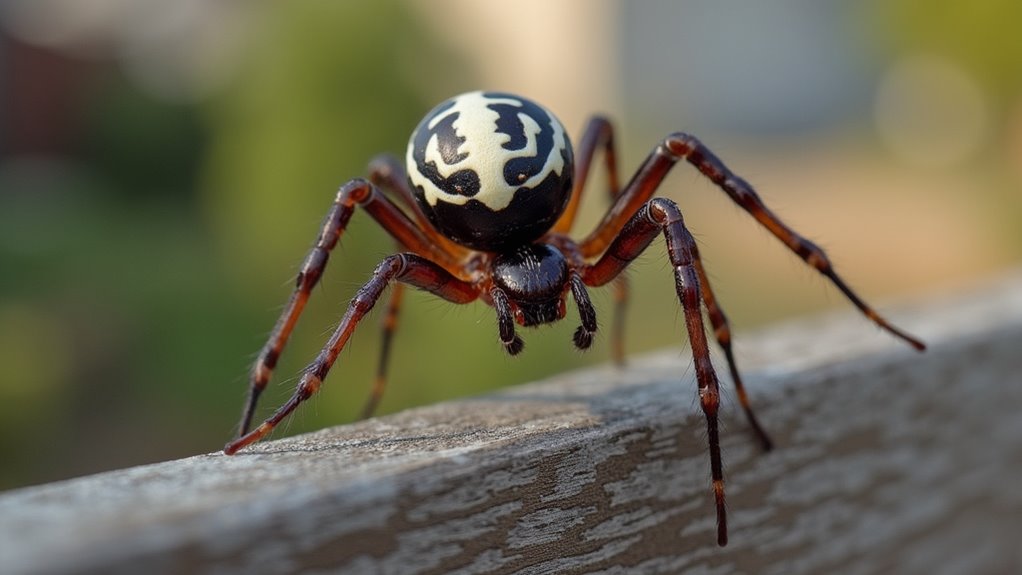
Quietly making their way across the Atlantic, Noble False Widow spiders have established themselves as California’s newest arachnid residents. Originally from Madeira and the Canary Islands, they’ve spread to several California counties including Ventura, Monterey, and San Diego.
You’ll recognize these European invaders by their brown or reddish-brown bodies with light markings—often mistaken for black widows. Their irregular, messy webs appear in urban areas, parks, and under garbage cans.
What makes them successful invaders? Their remarkable adaptability. They survive for months without food or water, tolerate various temperatures, and produce egg sacs containing 200+ eggs multiple times per season.
While their bites aren’t as dangerous as black widows’, increasing bite reports have raised public health concerns. Scientists believe their introduction was likely facilitated through ornamental plant imports rather than solely through banana shipments as previously thought.
If you’re taking a road trip from San Francisco to Portland, you might spot these spiders in northern California regions along your journey.
Unlike their stealthy European counterparts, jumping spiders bring a splash of personality to California’s arachnid landscape. With their distinctive large eyes offering nearly 360-degree vision, these spiders actively hunt prey rather than relying on webs.
California’s jumping spiders dazzle with personality, sporting panoramic vision as they actively pursue prey without web assistance.
You’ll recognize these fascinating creatures by their:
These agile hunters use silk draglines as safety tethers during jumps. Like Ohio’s venomous snake species, they’ve evolved specialized hunting techniques suited to their environment. Their impressive vision comes from specialized eye structure including anterior median eyes that provide high-resolution color detection and depth perception. They’re commonly found in your garden and occasionally indoors.
Though tiny, their complex courtship behaviors and precise hunting techniques make them among the most charismatic spiders you’ll encounter in California.
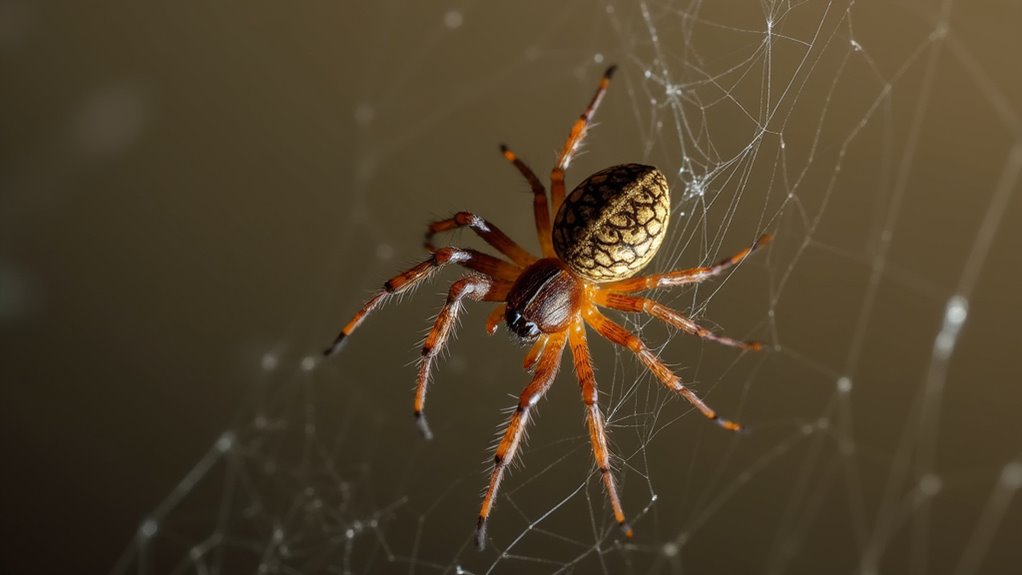
When you notice cobwebs in your ceiling corners or cluttered storage areas, you’re likely seeing the handiwork of American house spiders. These common arachnids prefer dark, damp environments throughout your home, especially near moisture sources like kitchens and bathrooms.
You’ll recognize them by their brown or grey bodies with darker stripes, oval abdomens with distinctive patterns, and dark rings on their legs. Females, which are larger than males, stay in their messy webs, maintaining them regularly, while males wander in search of mates. These remarkable creatures often incorporate leaves or debris into their webs to better conceal themselves from potential threats.
Though they might seem intrusive, these spiders actually help control insect populations in your home. Their bites aren’t harmful to humans, making them easy to coexist with. Unlike the pristine coastal hotspots of Florida, California homes often host these beneficial arachnids year-round.
If you’d prefer fewer eight-legged roommates, simply reduce clutter and remove webs periodically.
You’ll encounter these seven spider species just as you find other California wonders. While exploring a trail, the same sun that warms your skin might illuminate a tarantula’s burrow or a black widow’s web. They’re part of your everyday environment, whether you notice them or not. Understanding these common species helps you appreciate their ecological role and guarantees you’ll handle any chance meetings with knowledge instead of fear.